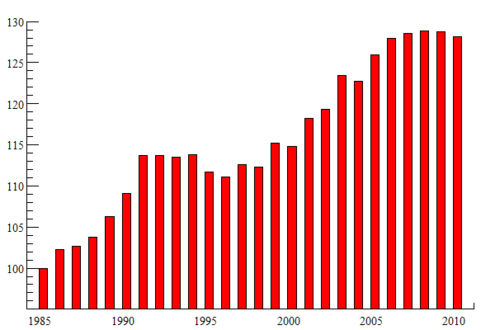Improvement and broadening of the Dutch drinking water benchmark
PhD: ir. Marieke de Goede Promotor CiTG: prof.dr.ir. Jan Peter van der Hoek
Daily supervisor CiTG: dr.ir. Ignaz Worm Promotor TBM: prof.dr.ir. Wil Thissen
Daily supervisor TBM: dr.ir. Bert Enserink
Research objectives
This study is initiated to develop a framework to broaden and renew the Dutch drinking water benchmark. The benchmark can be broadened by adding new subjects to it. The idea is that adding new subjects will push organizations to learn and improve on these subjects leading to improvement of the drinking water supply sector. The research develops a framework that decides on adding new themes and deleting “exhausted” themes.
Project outline
Introduction
Benchmarking is a management instrument for performance comparison. In the drinking water sector it serves two goals. On the one hand improvement of the performances of the water supply companies and on the other hand it is a form of accountability for the sector (ILT 2012). The drinking water benchmark is first executed over the year 1997. Since then, the productivity of the drinking water supply sector has significantly improved (Dumaij and van Heezik 2012).
Approach
First an evaluation of the current drinking water benchmark is executed to get an overview of the effects of the Dutch drinking water benchmark. This evaluation is performed by literature research and interviews with the Dutch drinking water companies. Based on this evaluation a framework will be designed to make the benchmark fit for the future.
Results
When the drinking water benchmark is made fit for the future, with the use of the framework, the negative effects of the current benchmark are expected to be solved:
- The current drinking water benchmark has two goals: improvement and justification. If a benchmark serves two goals, organizations can become too focused on showing that there level of performance is sufficient that the improvement objective is under pressure (de Bruijn 2002).
- Benchmarking can slow down innovation: innovation means exploring of the unknown. Innovation increases the risk that the results are lower than expected. Benchmarking rewards reproduction of the known.
- The learning effect from the Dutch drinking water benchmark seems to be decreased. While productivity grew between 2000 and 2008, currently the growth stopped, as can be seen in Figure 1.
- Variations in performances between drinking water supply organizations have decreased. Because of small variation, there is less differentiation between good and bad performance. This makes the impact and learning effect of the benchmark smaller (van Helden and Brouwer 2005).
- Participating in the benchmark became mandatory in 2012. When performance measurements become mandatory the chances of undesired effects (i.e. strategic behavior) increase. The measures become targets and as Goodhart’s law explains: ‘When a measure becomes a target, it ceases to be a good measure’.
- The Dutch drinking water benchmark only has attention for the short term, and does not focus on long term plans of organizations.

Figure 1: Productivity index numbers of drinking water
Further research plan
The goal to make the benchmark fit for the future requires that themes that are benchmarked should be able to change, because the future changes and some themes lose impact and get exhausted. Besides future developments and consumer preferences, also “sudden events” will be incorporated as in input variable. The research is framed along six specific research questions:
- How can a benchmark be made fit for the future?
- How can consumer preferences be integrated in a benchmark?
- How can “sudden events” be translated into a benchmark?
- What should a framework – that integrates future changes and “sudden event”, that decide on adding new themes and deleting “exhausted” themes and that incorporate consumer preferences – look like?
- What are the effects of application of the framework?
- How does the designed framework fits in the current governance structure of the Dutch water sector?
Social relevance
Improvement of the Dutch drinking water benchmark should lead to improvement of the drinking water supply sector. Making the benchmark fit for the future will lead to a situation where drinking water organizations are learning from each other again. This is expected to improve their performance on the subjects which fit with the changed environment the drinking water companies operate in. Good performance on these subjects is expected to improve the overall performance of these organizations.
Literature
- de Bruijn, H. (2002). Managing Performance in the Public Sector. London, Routledge.
- Dumaij, A. C. M. and A. A. S. van Heezik (2012). Productiviteitstrends in de drinkwatersector - Een empirisch onderzoek naar het effect van regulering op de productiviteitsontwikkeling tussen 1985 en 2010. Delft, TU Delft.
- ILT (2012). Protocol prestatievergelijking drinkwaterbedrijven 2012. Den Haag, Inspectie Leefomgevinng en Transport.
- van Helden, J. and N. Brouwer (2005). “Benchmarking en prestatieverbetering in de publieke sector - Ervaringen met de bedrijfsvergelijking zuiveringsbeheer.” Maandblad voor accountancy en bedrijfseconomie(6): 9.